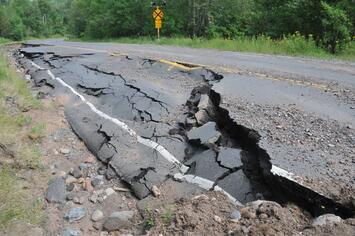
We were once a nation of builders—from the toll roads and canals of the early nineteenth century and the railroads of the second half of that busy century, to the construction of power, energy, and water systems that were the envy of the world. Even Stalin hired American engineers and planners to build hydroelectric plants and car and other large-scale factories, some planned and developed by people from Detroit.
As Stalin knew, infrastructure is one of the keys to imperial power. Ancient Rome, the imperial dynasties of China, the Mesoamerican empires, the Islamic empire of the Caliphs, the British Empire, and finally our own global imperium all rested on massive infrastructure projects.
In the United States, American ingenuity, usually private but with public assistance, built the world’s largest industrial economy. In the 1930s, we produced the Hoover Dam, the Tennessee Valley Authority, and countless bridges, roads, and other critical infrastructure. When the Second World War broke out, America had the capacity, in a remarkably short time, to become “the Arsenal of Democracy.” Historian Richard Overy notes that “the material explanation for victory” lay largely in America’s relentless productive capacity.
From Success to Failure: The Decline of American Infrastructure
Economic historian Robert Gordon has described the rapid economic growth in the period of the 1920s to the 1950s as “one of the greatest achievements in all of economic history.” Yet today, once again faced with a powerful, sustained challenge by powerful autocracies—China, Russia, and Iran—the West and America have allowed our productive capacity to deteriorate. As we saw in the pandemic, and now again after the Russian invasion of Ukraine, the U.S. and the West struggle to produce industrial products, including those of a military nature, that could prove critical in containing the new version of the early 1940s “pact of steel.”
The more recent decline of the West’s productive capacity—China now boasts as much industrial export capacity as the U.S., Japan, and Germany combined—has many causes, including insufficient investment in basic productive infrastructure. Much of this can be traced to regulators, particularly on climate related issues, who have, among other things, raised energy costs and contributed to the undermining of the electrical grid both in the U.S. and Europe. Even our military technology is increasingly dependent on Chinese inputs, most ominously in submarines.
Today no one would look at America as a great example of infrastructure development, whether for transportation, energy, or the development of human capital. Once a leader, much of our infrastructure is nearly a century old. Every four years, the American Society of Civil Engineers (ASCE) produces its Report Card for America’s Infrastructure. Roads, ever more important in an era of rapid dispersion, have a grade of “D” even as 91 percent of all non-telework commutes are by car and nearly 45 percent of freight ton-miles are moved by truck.
Read the rest of this piece at American Mind.
Joel Kotkin is the author of The Coming of Neo-Feudalism: A Warning to the Global Middle Class. He is the Roger Hobbs Presidential Fellow in Urban Futures at Chapman University and and directs the Center for Demographics and Policy there. Learn more at joelkotkin.com and follow him on Twitter @joelkotkin.
Wendell Cox is principal of Demographia, an international public policy firm located in the St. Louis metropolitan area. He is a Senior Fellow with the Frontier Centre for Public Policy in Winnipeg and a member of the Advisory Board of the Center for Demographics and Policy at Chapman University in Orange, California. He has served as a visiting professor at the Conservatoire National des Arts et Metiers in Paris. His principal interests are economics, poverty alleviation, demographics, urban policy and transport. He is co-author of the annual Demographia International Housing Affordability Survey and author of Demographia World Urban Areas.
Photo: FEMA/Norman Lenburg, in Public Domain (U.S. Government Work).












